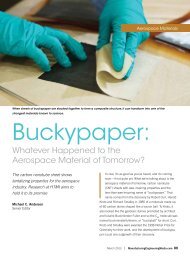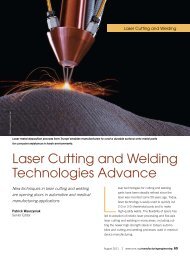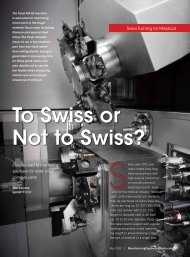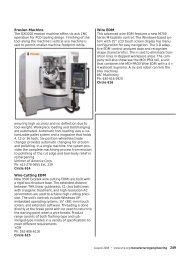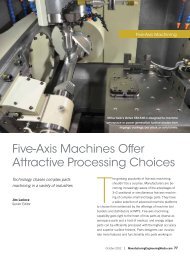Click here for PDF - Society of Manufacturing Engineers
Click here for PDF - Society of Manufacturing Engineers
Click here for PDF - Society of Manufacturing Engineers
Create successful ePaper yourself
Turn your PDF publications into a flip-book with our unique Google optimized e-Paper software.
Materials<br />
second in size only to orthopedics.<br />
Cardiac applications call <strong>for</strong> companies<br />
that are good with wires; pulling wires<br />
and <strong>for</strong>ming wires ... nitinol use is at the<br />
<strong>for</strong>efront <strong>of</strong> much <strong>of</strong> that.”<br />
Photo courtesy Symmetry Medical<br />
Hip implants made from Ti-64.<br />
Competing in the Disposables Sector<br />
Plastics are playing an important role<br />
in the disposables market. For hospitals,<br />
one-use products such as syringes and<br />
IV bags are easier to deal with, in terms<br />
<strong>of</strong> quality and sterilization concerns,<br />
said MacNeal.<br />
“If it’s a single-use throwaway, you<br />
know that unless t<strong>here</strong> was a problem at<br />
the manufacturer’s sterilization facility,<br />
the product can be trusted. On the other<br />
hand, disposables are costly. And in<br />
particular, how are you going to enter the<br />
emerging markets w<strong>here</strong> a lot <strong>of</strong> industry growth is happening,<br />
when these products are so expensive While a single disposable<br />
product itself may be cheap, the number needed can<br />
make them an expensive choice.<br />
“Some hospitals are looking at reclaim and reuse, and<br />
considering investing in metal versions <strong>of</strong> the products and<br />
sterilization processes and reuse instead <strong>of</strong> disposables.<br />
“The cardiac sector <strong>of</strong> the medical<br />
device industry is huge—second<br />
in size only to orthopedics.”<br />
Our company is working with an OEM to develop a disposable<br />
metal suturing device. In this case metal is desirable <strong>for</strong><br />
its strength. T<strong>here</strong>’s a cantilevering action involved <strong>for</strong> which<br />
plastic just isn’t strong enough in the size the company is<br />
looking at. But machining the piece from metal would be<br />
prohibitively expensive, so they’re looking at manufacturing<br />
the device through the use <strong>of</strong> metal injection molding—MIM,<br />
one <strong>of</strong> our company’s primary technologies.<br />
MIM: Sinter <strong>of</strong> Excellence<br />
“With MIM, you start with powdered metal with a consistency<br />
similar to flour, and mix it with a binder—usually a<br />
polymer—and heat it so that the binder can flow but the metal<br />
84 <strong>Manufacturing</strong>EngineeringMedia.com | May 2013






